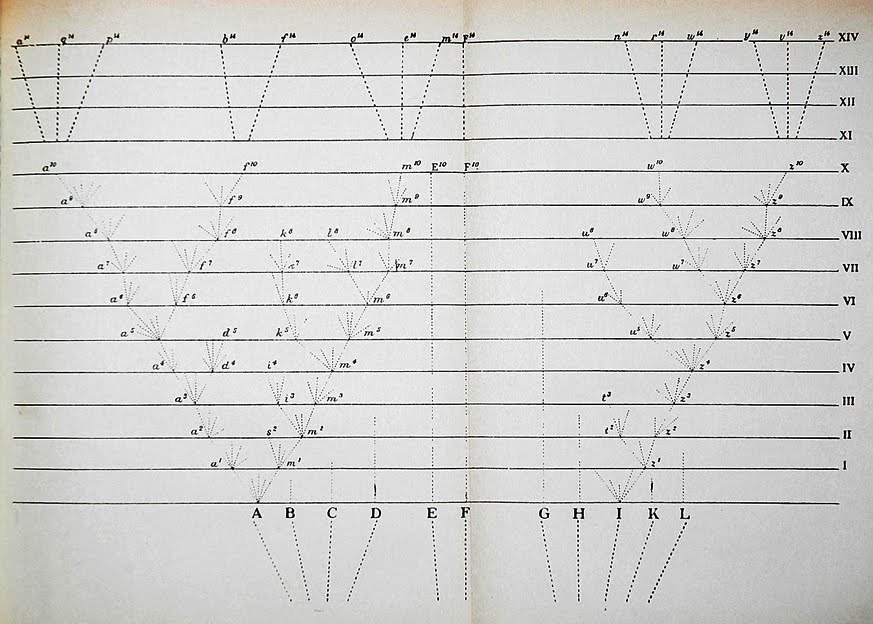![]()
Corrigiendo algún otro error en el párrafo centésimo septuagésimo segundo de El Origen de las Especies

Si el tiempo avanza, entonces los nichos ecológicos cambian y nadie ocupa el lugar de nadie. Ninguna línea destruye a otra.
The modified offspring from the later and more highly improved branches in the lines of descent, will, it is probable, often take the place of, and so destroy, the earlier and less improved branches,….
La descendencia modificada de las ramas más modernas y más perfeccionadas de las líneas de descendencia probablemente ocupará con frecuencia el lugar de las ramas más antiguas y menos perfeccionadas, destruyéndolas así,….
172.
As all the modified descendants from a common and widely-diffused species, belonging to a large genus, will tend to partake of the same advantages which made their parent successful in life, they will generally go on multiplying in number as well as diverging in character: this is represented in the diagram by the several divergent branches proceeding from (A). The modified offspring from the later and more highly improved branches in the lines of descent, will, it is probable, often take the place of, and so destroy, the earlier and less improved branches: this is represented in the diagram by some of the lower branches not reaching to the upper horizontal lines. In some cases no doubt the process of modification will be confined to a single line of descent, and the number of modified descendants will not be increased; although the amount of divergent modification may have been augmented. This case would be represented in the diagram, if all the lines proceeding from (A) were removed, excepting that from a1 to a10. In the same way the English racehorse and English pointer have apparently both gone on slowly diverging in character from their original stocks, without either having given off any fresh branches or races.
Como todos los descendientes modificados de una especie común y muy difundida perteneciente a un género grande, tenderán a participar de las mismas ventajas que hicieron a sus padres triunfar en la vida, continuarán generalmente multiplicándose en número, así como también divergiendo en caracteres: esto está representado en el cuadro por las varias ramas divergentes que parten de A. La descendencia modificada de las ramas más modernas y más perfeccionadas de las líneas de descendencia probablemente ocuparán con frecuencia el lugar de las ramas más antiguas y menos perfeccionadas, destruyéndolas así, lo que está representado en el cuadro por alguna de las ramas inferiores que no alcanza a las líneas horizontales superiores. En algunos casos, indudablemente, el proceso de modificación estará limitado a una sola línea de descendencia, y el número de descendientes modificados no aumentará, aunque puede haber aumentado la divergencia de la modificación. Este caso estaría representado en el diagrama si todas las líneas que parten de A fuesen suprimidas, excepto la que va desde a1 hasta al a10. De este modo, el caballo de carreras inglés y el pointer inglés han ido evidentemente divergiendo poco a poco en sus caracteres de los troncos primitivos, sin que hayan dado ninguna nueva rama o raza.
